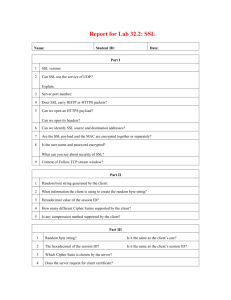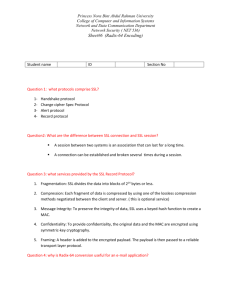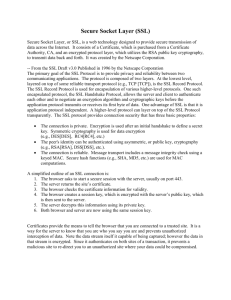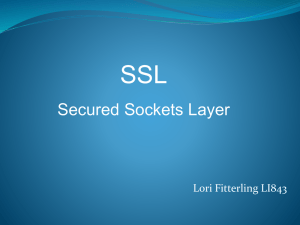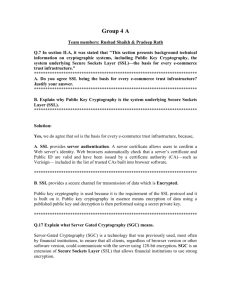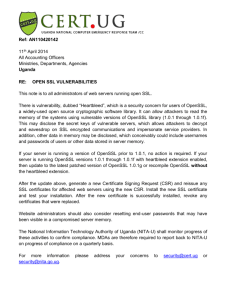Dini
advertisement
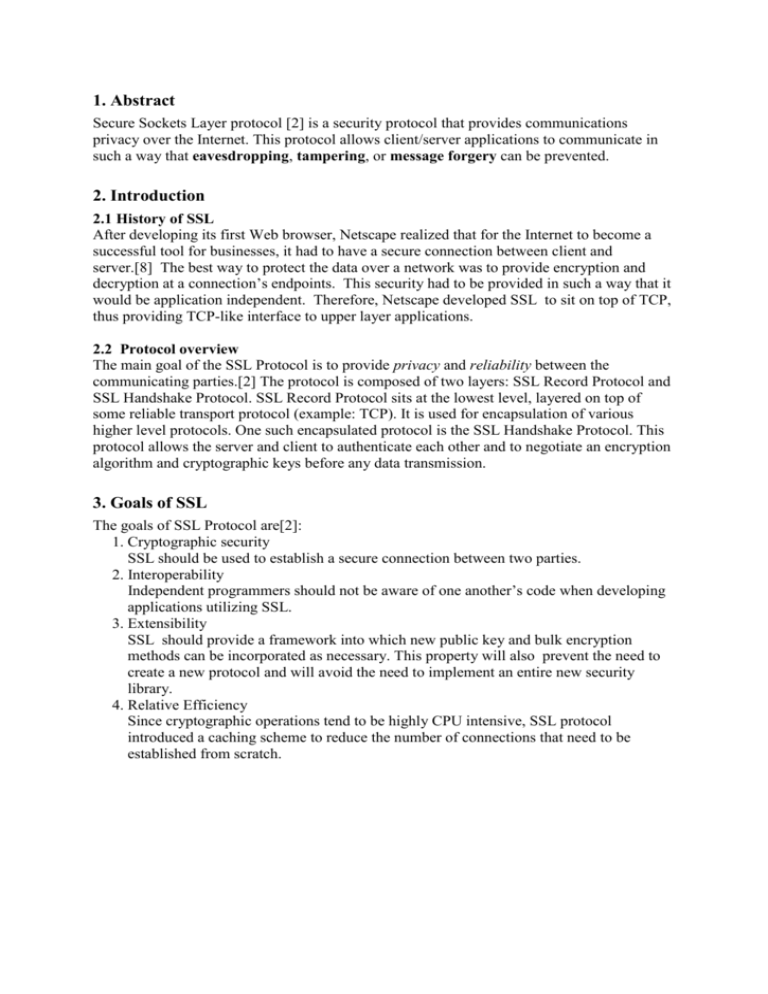
1. Abstract Secure Sockets Layer protocol [2] is a security protocol that provides communications privacy over the Internet. This protocol allows client/server applications to communicate in such a way that eavesdropping, tampering, or message forgery can be prevented. 2. Introduction 2.1 History of SSL After developing its first Web browser, Netscape realized that for the Internet to become a successful tool for businesses, it had to have a secure connection between client and server.[8] The best way to protect the data over a network was to provide encryption and decryption at a connection’s endpoints. This security had to be provided in such a way that it would be application independent. Therefore, Netscape developed SSL to sit on top of TCP, thus providing TCP-like interface to upper layer applications. 2.2 Protocol overview The main goal of the SSL Protocol is to provide privacy and reliability between the communicating parties.[2] The protocol is composed of two layers: SSL Record Protocol and SSL Handshake Protocol. SSL Record Protocol sits at the lowest level, layered on top of some reliable transport protocol (example: TCP). It is used for encapsulation of various higher level protocols. One such encapsulated protocol is the SSL Handshake Protocol. This protocol allows the server and client to authenticate each other and to negotiate an encryption algorithm and cryptographic keys before any data transmission. 3. Goals of SSL The goals of SSL Protocol are[2]: 1. Cryptographic security SSL should be used to establish a secure connection between two parties. 2. Interoperability Independent programmers should not be aware of one another’s code when developing applications utilizing SSL. 3. Extensibility SSL should provide a framework into which new public key and bulk encryption methods can be incorporated as necessary. This property will also prevent the need to create a new protocol and will avoid the need to implement an entire new security library. 4. Relative Efficiency Since cryptographic operations tend to be highly CPU intensive, SSL protocol introduced a caching scheme to reduce the number of connections that need to be established from scratch. 4. SSL Architecture Figure 1. SSL Architecture Figure 1 shows the architecture of SSL.[6] SSL consists of four protocols, each of them having specific roles. These protocols are: SSL Record protocol, SSL Handshake protocol, SSL Change Cipher Spec protocol, and SSL Alert protocol. SSL Record protocol provides two security services for SSL connections: confidentiality, obtained through encrypting application data and message integrity, obtained through the use of a MAC.[7] This protocol can be utilized by some other upper layer protocol of SSL such as handshake protocol. This protocol involves a number of operations. On the sender side the operations involved are fragmentation, compression, message integrity, encryption, addition of SSL header, and transmission. The receiver side involves decryption, verification, decompression, reassembling, and delivery to the calling application. SSL Change Cipher Spec protocol is used to signal the transition in ciphering strategies.[2]This protocol consists of a single message, which is 1 byte. The purpose of this message is to updates the CipherSuite that will be used on the current connection. SSL Alert protocol is used to communicate SSL-related alerts to the other party. The messages of this protocol include the severity of the message and the description of the alert. The messages with a level of fatal, result in immediate termination of the connection. SSL Handshake protocol is the most complex part of SSL. This protocol is used to establish a secure connection between the server and the client. It allows the client and the server to authenticate each other and also to negotiate several connection parameters such as cryptographic algorithms and keys used for encryption. The handshake protocol is divided in 4 phases: 1)establish security capabilities; 2)server authentication and key exchange; 3)client authentication and key exchange; 4)Change CipherSpec and Finish. Figure 2 [6] shows a simplified version of how a SSL session is established by following a handshake sequence between client and server. The four phases are divided by the dotted horizontal lines. Figure 2. Simplified SSL Handshake Sequence Phase 1: Establish security capabilities This phase is initiated by the client, which sends a client_hello message with the following parameters[7]: - SSL version supported by the client - Nonce: random number - Session identifier, which is of variable length - CipherSuite list, which contains the cryptographic algorithms supported by the client, sorted by the client’s preference. In here it is also defined a key exchange algorithm and a Cipher Spec. - Compression algorithm supported by the client and sorted by the client’s preference The server responds with a similar Hello message selecting, from the lists sent by the Client, its preferred Cipher Spec and compression algorithm. Phase 2: Server authentication and key exchange In this phase, the server sends a certificate that contains its public key. This is done if the server is asked to authenticate itself, which is usually the case. If there is no certificate, then the serve can send a key exchange message. The server can also request a certificate from the client. The last message in this phase is the server_hello_done message, sent by the server, which indicates the end of the server_hello and associated messages. After the client receives this message, it should verify that the server sent a valid certificate and that the server hello parameters are acceptable. Phase 3: Client authentication and key exchange In this phase the client sends its certificate if it was requested and if a certificate is available. The next message sent by the client is the ClientKeyExchange message, which contains the keys. The choice of messages depends on which public key algorithm(s) has (have) been selected. The last message of this phase is the ClientVerify message used in verifying the client’s certificate. Phase 4: Change CipherSpec and Finish. This phase is used to complete the establishment of a secure connection. A ChangeCipherSpec message is sent by both client and server. This messages notify the Record protocol of the newly negotiated keys and algorithms.[5] Following this message is the final message that completes the handshake phase, which is the Finished message. This message is used to verify that the key exchange and authentication processes were successful. Once this is done, the server and the client can send application data via SSL. 5. SSL limitations SSL provides some protection to Web transactions, but it is not the answer for every security concern.[4] SSL can guarantee two things: the server that one wants to contact is the one that one got and an attacker can’t read or modify the data that is being transmitted between a client and the Web server. Other security issues are not addressed by SSL. A list of things that SSL does not protect one from contains host insecurities, authentication issues, back-end clear text storage and transmissions, and SSL implementation flaws. Host insecurities Having an SSL-enabled Web server does not secure the machine itself. For example, if a machine runs an SSL-enabled Web server and an IMAP (Internet Mail Access Protocol) server, then the machine becomes vulnerable. IMAP servers are known to be prone to attacks. Authentication issues The SSL certificate is based on the host name. Anyone who owns a website can get a certificate. This would not be a problem if users do not make any mistakes such as typos. For example, one wants to go to www.my_bank.com, but instead types www.my_banks.com. If an attacker owns the latter website, then the above user may give away information that was not supposed to be disclosed to anyone other than his/her bank. The contents of the attacker’s page may look exactly the same as the contents of the real bank, and the user may never suspect that he/she is on the wrong web page. Back-end clear text storage and transmissions Many Web servers get and store data using outside sources, such as databases and flat files. This files may be sent somewhere else without using a secure channel. One may enter the credit card information via a secure channel, but the same information can be sent from the server to an outside database via an insecure channel. SSL implementation flaws Different vendors can have their own implementation of SSL, which can have different flaws. OpenSSL has been discovered to have multiple buffer overflow capabilities.[3] Fortunately, the software that uses OpenSSL code has been fixed and now the users running this software are not at risk anymore. Another SSL problem has been discovered with Microsoft Internet Explorer. The Internet Explorer does not properly check the digital certificates, which are supposed to guarantee a secure SSL connection. This flaw gives the possibility to anyone to mount “a man in the middle” attack. In an usual case, the administrator of a web site, generates a certificate and a Certificate Authority signs it.[1] The certificate should contain the URL of the secure web site in the Common Name field. After the CA verifies that the administrator legally owns the URL, signs the certificate and returns it to the owner. An example of a certificate would be [CERT - Issuer: VeriSign / Subject: VeriSign] -> [CERT - Issuer: VeriSign / Subject: www.my_page.org] When a web browser receives this certificate, it should verify that the CN field matches the domain it just connected to, and that it's signed using a known CA certificate. If all these steps are followed, then no “man in the middle” attack should be possible. A substitution of a valid certificate should not be possible. Problems appear when intermediate CAs are part of picture. Since there are not too many CAs , sometimes it is easier to delegate signing authority to other authorities. For example, the above certificate would look like [Issuer: VeriSign / Subject: VeriSign] -> [Issuer: VeriSign / Subject: Intermediate CA] -> [Issuer: Intermediate CA / Subject: www.my_page.org] When a browser receives this, it should verify all the CAs present on the certificate. Also, it should check that the intermediate CA meets the CA Basic Constraints. If this is done, then there should not be any problems. However, Internet Explorer does not check these Basic Constraints, and there is where the problems appear. As a consequence of this flaw, anyone with a valid CA-signed certificate for any domain can generate a valid CA-signed certificate for any domain. If this vulnerability is combined with a hijacking connection technique, “a man in the middle” attack can be produced. 6. References 1. Benham, Mike. Internet Explorer SSL Vulnerability. August 2002, accessed March 27,2004 from http://www.securityfocus.com/archive/1/286290/2002-07-31/2002-0806/0. 2. Freier, Alan, Philip Karlton, Paul C. Kocher. SSL Protocol version 3.0. November 18 1996, accessed from http://wp.netscape.com/eng/ssl3/draft302.txt 3. Glass, Brett. Security Update 15 Aug 2002. Extreme Tech.August 2002, accessed March 26,2004 from http://www.extremetech.com/article2/0,1558,471915,00.asp 4. Hatch, Brian. SSL is Not a Magic Bullet. Hacking Linux Exposed. April 2002, accessed on March 26,2004 from http://www.hackinglinuxexposed.com/articles/20020423.html 5. Onyszko, Tomasz. Secure Socket Layer. July 19, 2002, accessed March 31,2004 from http://www.windowsecurity.com/articles/Secure_Socket_Layer.html 6. SSL/TLS Strong Encryption: An Introduction. Accessed March 31,2004 from http://httpd.apache.org/docs-2.0/ssl/ssl_intro.html#ssl 7. Stallings, William. SSL:Foundation for Web Security. The Internet Protocol Journal, June 1998. http://skaiste.elekta.lt/Books/Cisco/CiscoPublic/ipj_1-1_SSL1.html 8. Wesley, Chou (2002). Inside SSL: The secure sockets layer protocol. IT Professional, Volume4, 47-52. Table of Contents 1. Abstract 2. Introduction 2.1. History of SSL 2.2. Protocol Overview 3. Goals of SSL 4. SSL Architecture 5. SSL Limitations 6. References CS 265 Project: Secure Socket Layer Protocol By Oana Dini CS 265 Spring 2004 Date: April 5th, 2004 Prof: Dr. Mark Stamp


